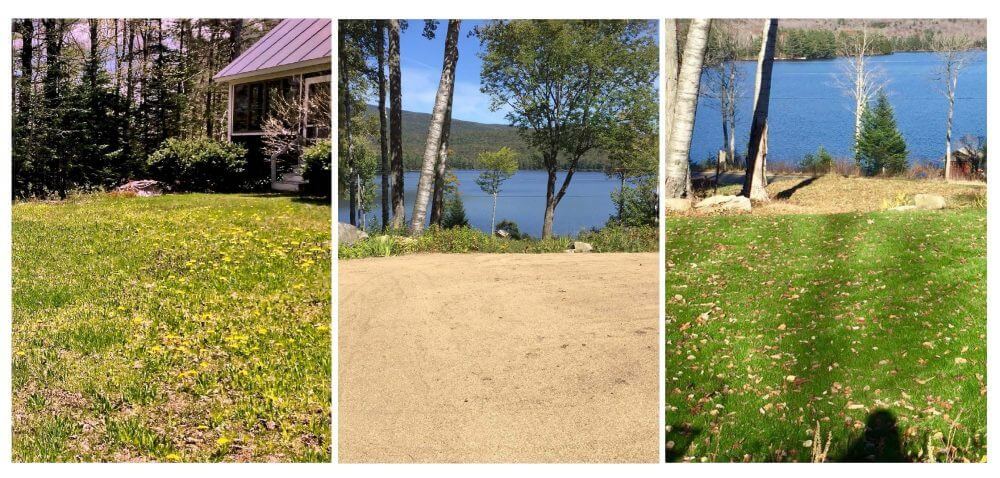You may be one of the many New England residents who experienced partial to complete lawn damage as a result of the drought of 2016. At this point, you are likely wondering what next? Well, you are not alone and the seemingly daunting task of having your lawn repaired does not have to be a horror show. This post explains how Chippers approaches lawn renovations, accompanied with before, during and after photographs of a job completed this fall.
Assessment
The first step in any lawn renovation is having an experienced landscape or lawn professional come in and assess the extent of the damage. In many cases, a complete redo is not necessary, saving you lots of money. If more extensive work is needed, the process described below should help you decide if it’s best to be done by a professional.
The first photograph, taken this spring, shows a lawn that is mostly weeds and thin with prior lawn damage. The client decided to start fresh and called in Chippers for a site visit and quote to redo the entire lawn area (about 5,000 sqft, a small lawn, just over 1/10 of an acre).
Loam vs. Rototilling
There are many benefits to not rototilling the existing lawn and simply adding better loam on the surface of the old lawn, usually to a depth of 1-3”. The decrease in the amount of topsoil needed saves money yet provides a decent seeding bed for a new lawn to grow into the old lawn. Not tilling under the old lawn also prevents dormant weed seeds from being brought to surface to germinate and compete with the new grass seed. Tilling usually brings up rocks and other debris, adding labor costs as they are removed. Burying the old lawn also saves time in respect to raking out and or adding soil amendments. High quality screened loam with added compost is virtually stone free and makes for a substantial base for the new lawn installation.
In this particular lawn, due to the extensive weeds, the existing lawn was sprayed with an herbicide by our licensed technician before loam was added. This prevented weeds from popping up from underneath the new loam applied directly on top of the old lawn. The second photograph shows the lawn after it was sprayed for existing vegetation and the new loam was spread out, nearly ready for seeding.
Seed Selection
Selecting the right grass seed for the site is the key to a successful lawn renovation and is often overlooked. Now is the time to select grasses for the specific site conditions, such as substantial shade, future use (play/sports), sun exposure, windy areas etc. Chippers selects the most appropriate seed blends and uses them in different areas as is appropriate for success. Using a single blend or a generic “sun/shade” mix is really not doing the job properly. It is not uncommon for us to use three or even four distinct blends on a single lawn renovation, regardless of size.
Post Seeding Application
After the lawn is seeded, Chippers usually applies a high calcium lime coated with enzymes and a natural fertilizer to help with germination and subsequent early growth/establishment. Chippers also applies compost tea to improve soil biology and organic matter in the weeks after seeding. The final photo shows the finished lawn, about six weeks after the actual seeding occurred and the treatments described above were implemented.
Timing
This lawn renovation was done in mid-September (fall being the ideal time for lawn restorations, see post Organic Fall Lawn Care for more on this subject). Lawn repairs can occur in the spring but additional safeguards need to be included to address disease and crabgrass as they have the potential to reduce overall results. However, if you don’t have a lawn, it is nice to move forward in the spring and get something established, even if it means touching things up in the fall due to unforeseen weather or other circumstances.
As 2016 winds down, there is still time to have a professional review your damaged lawn and present options for the spring or fall of 2017. Chippers has decades of experience repairing and caring for lawns, so don’t hesitate to make an inquiry. If we don’t service your area, we may be able to provide a referral in your town. Best of luck and don’t get overwhelmed – there is help and real solutions to have the green, lush lawn you desire.

Lawn Renovation 101
Tags:
chippers
, drought damage
, lawn renovation
, nh lawn care
, vt lawn care
, lawn damage
, concord lawn companies

